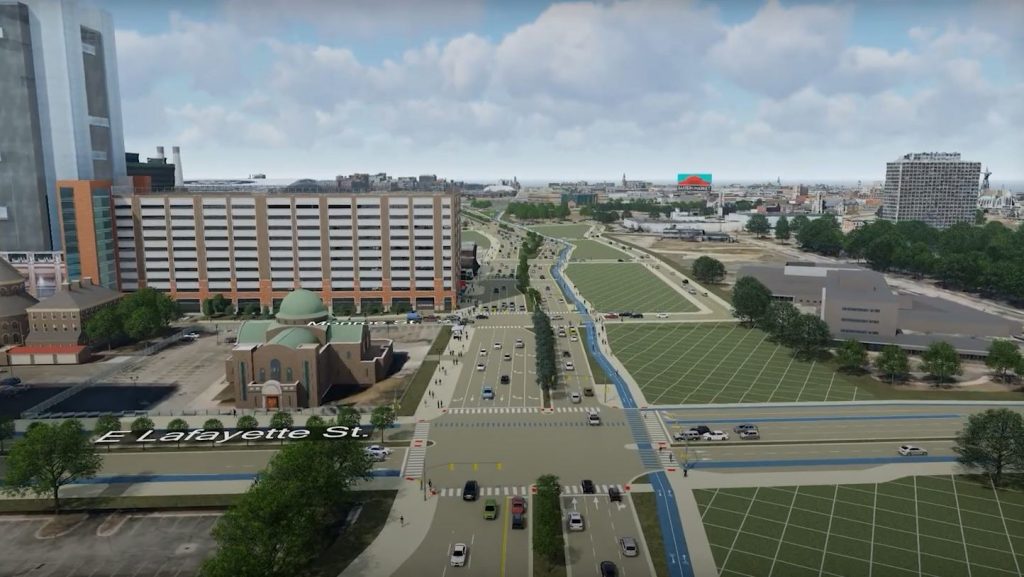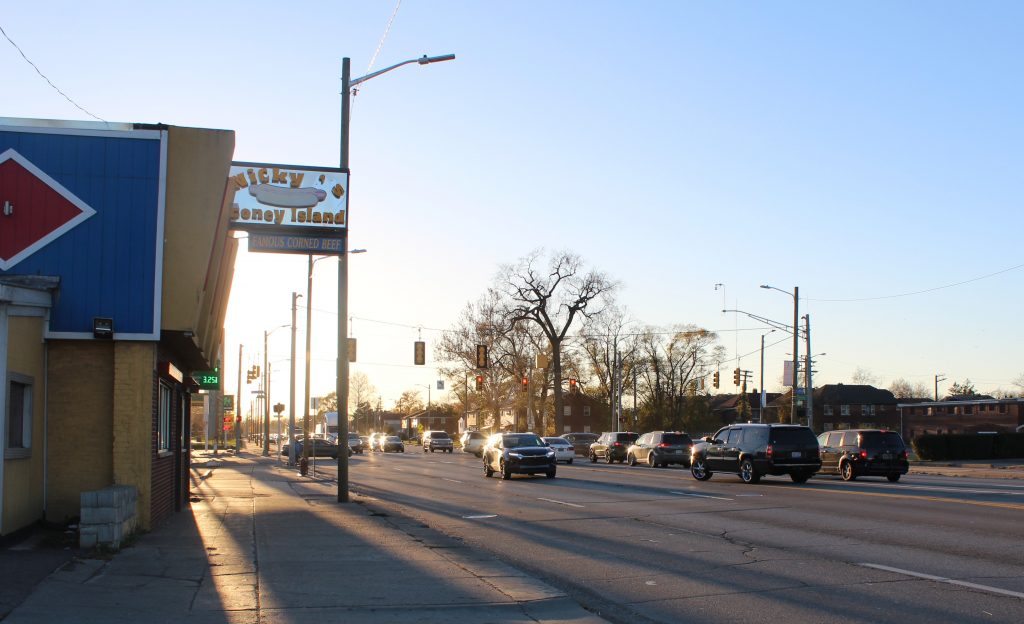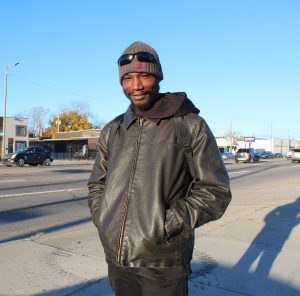Will the new I-375 boulevard be like the Davison?
West Davison in Detroit has similarities with the boulevard being proposed to replace I-375. But pedestrians say that the multi-lane roadway isn’t easy to navigate.

A rendering of a boulevard that MDOT is proposing to replace I-375.
The construction of I-375 in downtown Detroit beginning in the late 1950s hastened the destruction of the majority Black neighborhoods around it – Black Bottom and Paradise Valley.
In the past few years, the Michigan Department of Transportation (MDOT) has been working on a project to reimagine the below grade freeway. The state received $105 million from the federal government for the project in 2022. The funds were part of a host of grants meant to reconnect communities negatively impacted by highways. Preliminary plans for a newly-designed roadway have been released.
For the proposed redesign, MDOT officials are planning to replace I-375 with a street-level boulevard that would primarily have six lanes but would have as many as nine lanes. According to the plan, drivers heading south would travel from the I-75 freeway onto this new boulevard.
At a Detroit City Council meeting on Nov. 7, MDOT senior project manager Jon Loree showed a virtual rendering of what I-375 could look like after its transformation.
“So, you see the boulevard is typically three lanes in each direction. It’ll be a 30 mph posted speed,” Loree told council and the rest of the audience. “[There will be] really wide sidewalks on the central business district side, which is on the right of this drawing, so, 20-foot sidewalks. And then we have a buffer and a two-way bicycle track that is at the sidewalk level, and then a 10-foot sidewalk behind that.”
The conversion from a freeway to a boulevard would not only provide the opportunity to update aging infrastructure, installing a boulevard would take up less space and free up land that could be used for greenspace or to support new businesses. The project would also help divert stormwater drainage from combined sewers into the Detroit River.
But the plan has its critics.
I-375 plan is receiving pushback
Neil McEachern lives in Lafayette Park, a neighborhood adjacent to I-375 that was built as part of the “urban renewal” process. During public comment, he reflected on a meeting about the project that was held in his neighborhood on Nov. 4 by Michigan State Sen. Stephanie Chang.
“I don’t think that anybody in the neighborhood — at least based on the number of people that came to the town square meeting on Saturday — are in favor of a nine-lane highway going through our neighborhood. That would just cut us off from downtown in a way that the lower freeway now does not do,” he said.
McEachern currently uses an overpass to cross from his neighborhood to downtown. But now he’ll have to use a crosswalk on the same level as the cars to traverse several lanes of traffic.
City Councilmember Mary Waters told meeting attendees she lives in the area and can relate to residents’ concerns. Councilmember Angela Whitfield Calloway said she’s not happy with MDOT’s plans, either.
“I do not support a nine-lane freeway. That’s what we’re trying to avoid. So, I’m going on the record today, from what I’ve seen, I do not support the nine lanes.”
Though McEachern called the new road a “highway” and Calloway called it a “freeway,” it’s not meant to be either. As mentioned, MDOT is planning to turn I-375 into a six- to nine-lane boulevard with a speed limit of 30 mph. Still, the confusion isn’t completely unfounded.

What if the new I-375 boulevard is like West Davison?
West Davison Avenue in Detroit, a roadway that flows out of the M-8 Davison Freeway to the east and into I-96 further west, sounds very much like a freeway from its sidewalks.
The design of West Davison is different from what’s planned for the I-375 boulevard. The 1.5-mile long route doesn’t have a median, its sidewalks aren’t widened, and there’s no buffered track for bicycles. But like the I-375 plan, West Davison primarily has six lanes, it has a speed limit in the 30s, and it’s the extension of a freeway. So, this could be a good example of what I-375 might feel like after it’s turned into a boulevard. MDOT keeps saying that it is designing the boulevard for all users. So, it seems worth investigating what West Davison is like for pedestrians.

On a recent weekday afternoon, Juvon Josey was wearing headphones and walking down the sidewalk of West Davison toward a cell phone shop. He doesn’t only use these headphones to listen to music. He also uses them to block out the sounds of the traffic.
“I’m HSP, a highly sensitive person,” Josey said. “So like, I’m real sensitive to like, police car sirens, fire truck sirens. That’s why I have my headphones on a lot.”
Nhashae Parker was making her way home from the store. A couple yellow plastic bags were hanging from her wrist as she darted through traffic to cross the street in-between crosswalks.
Parker said because I-375 comes off of I-75, she doesn’t think it’s a good idea to turn it into a roadway like the Davison.
“There’s more traffic than this down there. That is extreme traffic,” Parker said. “I’m scared for that.”
Another pedestrian, Daylan Fields, said walking along West Davison during rush hour is a bad idea.
“It’s terrible! You kind of really can’t even cross the Davison. Not around this time, right now. You’re gonna have to wait a little bit,” he said. “And it’s kind of scary crossing Davison, you know, because of the traffic. People speeding… Even at a crosswalk.”
So if the new boulevard downtown ends up being anything like West Davison, it sounds like it could be an unpleasant, potentially dangerous experience for pedestrians.
“No comparison”
MDOT’s Jon Loree said he doesn’t think the new I-375 boulevard will end up like West Davison.
“Yeah, there’s really no comparison,” said Loree. “That Davison stretch is really a connector between the M-8 [Davison] Freeway or between M-10 [the Lodge] and I-96, and serves a lot of through traffic and truck traffic.”
Loree said there’s not really anything in Detroit yet like the I-375 boulevard MDOT has showed in its renderings.
And even that model might evolve.
After getting pushback, the department is planning to gather post-pandemic traffic information and perform a new engineering analysis to better-inform the design.
“Maybe we don’t need some of these lanes that we needed and forecasted back in 2017,” Loree said. “We don’t know exactly what that looks like at this point, but we’re committed to doing that because we’ve heard those concerns from the community.”
MDOT recently announced it’s pushing back a public meeting until 2024 that was originally planned for this month.
MDOT is delaying its next public meeting on the removal of I-375 to 2024.
“Based on your constructive feedback the project team has decided to modify its approach.”
Some of the feedback: https://t.co/Q2MVM5Rejt pic.twitter.com/7I1llA4PWV
— Jena Brooker (@j_e_n_a_b) November 10, 2023
The agency says it wants to get this project right. Many watching the project say, given the freeway’s history with uprooting Black residents, it’s absolutely critical that that happens.
More from WDET:
- Reckoning 375: Why advocates say centering Black voices is key in I-375’s redevelopment
- Reckoning 375: MDOT explains why it’s replacing I-375 with a boulevard
- CuriosiD: How A 1900s Black Detroit Community Was Razed For A Freeway
Trusted, accurate, up-to-date.
WDET strives to make our journalism accessible to everyone. As a public media institution, we maintain our journalistic integrity through independent support from readers like you. If you value WDET as your source of news, music and conversation, please make a gift today.
